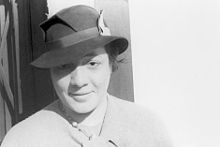Barron Wilkins' Exclusive Club
Barron Wilkins 'Exclusive Club , also known as Barron Wilkins' or Barron’s , was a popular nightclub in the late 1910s and early 1920s in the Harlem borough of New York and one of the focal points of the Harlem Renaissance , which Noble Sissle considered the first to be introduced to black musicians to a wealthy white audience.
Founded in 1915 and existed until the early 1920s, Barron's Exclusive Club was one of the most popular venues in Harlem and was a forerunner of later successful clubs such as the Cotton Club , Small's Paradise and Connie's Inn . Businessman Barron D. Wilkins opened the club at 198 West 134th Street and Seventh Avenue. Wilkins, who was also a local politician and funder of black boxers and baseball teams , had previously run a number of such eateries in Midtown Manhattan and Harlem, including Little Savoy on West 35th Street.
In Barron's Exclusive Club , which as private club was led and provided for a formal evening dress, reversed an elitist white audience. Although it was called the Colored Club , African Americans were generally not allowed in, only light-skinned Negroes like comedian Bert Williams or boxer Jack Johnson were allowed, as Ada Smith recalled. Harlem Renaissance writer Rudolph Fisher (who was turned away for being too black) later wrote that Barron's wasn't just a Negro cabaret, but a cabaret run by blacks for whites .
Regular guests included a circle of politicians, artists and athletes such as Noble Sissle, Eubie Blake , Frank Fay, Al Jolson , George Gershwin , Joan Crawford and gangster Jack "Legs" Diamond. Performing artists included pianist James P. Johnson , band leaders Jim Europe and Sam Wooding , singers Valaida Snow and Ada Smith (1922), nicknamed Bricktop by Wilkins when he saw her earlier in Chicago, and Florence Mills . Ada Smith was able to convince Duke Ellington and his Washingtonians to come to Harlem from Washington, DC and perform at Barron's in 1923, where they played hits and background music before moving to the Kentucky Club . In May 1924, at the age of 63, Wilkins was shot dead by a gangster named Julius Miller and the club continued to operate under white management for a short time.
Leroy Wilkins, the older brother of Barron Wilkins, ran the Leroy’s nightclub , which, in contrast to Barron’s, had a purely African-American audience. Count Basie made his first appearance there in Harlem.
The painter Charles Demuth portrayed the club in a painting in 1917.
Web links
Individual evidence
- ↑ See The Harlem Renaissance as History, Memory and Myth (pdf; 2.4 MB) and Sandra L. West: Encyclopedia of the Harlem Renaissance 2003. Page 406
- ^ A b Mark Tucker: Ellington: The Early Years , p. 88
- ^ David Bradbury: Duke Ellington , p. 15
- ↑ Shane Vogel: The Scene of Harlem Cabaret: Race, Sexuality, Performance , p. 80
- ↑ Count Basie : Good Morning Blues: The Autobiography of Count Basie , p. 67
- ^ A b Howard Pollack: George Gershwin: His Life and Work , p. 52
- ^ Arnold Shaw: The Jazz Age: Popular Music in the 1920's , p. 82.
- ↑ Sam Wooding Post WWI Harlem
- ↑ James Lincoln Collier : Duke Ellington. Genius of Jazz ("Duke Ellington"). Ullstein, Berlin 1999, ISBN 3-548-35839-X . P. 63
- ^ Burton W. Peretti: Nightclub City: Politics and Amusement in Manhattan , p. 7
- ↑ See Tamara Stevens, Erin Stevens: Swing Dancing , p. 55 f.
- ↑ Jonathan Gill: Harlem The Four Hundred Year History from Dutch Village to Capital of Black America . ISBN 0802119107 , p. 196
